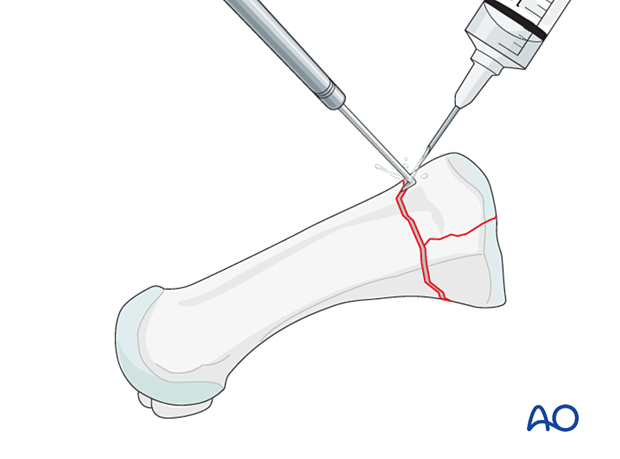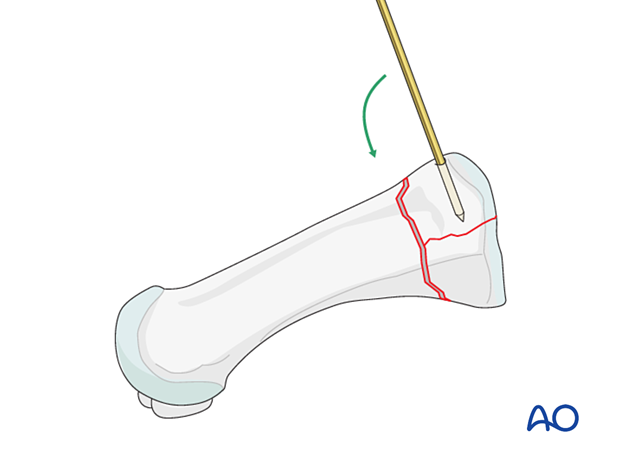Nonlocking plate fixation with/without lag screws of proximal articular fractures of the 1st–4th metatarsal
1. General considerations
Strategy options for complete articular fractures
The principle of this procedure is first to reduce and fix the articular block, which is then fixed to the shaft using a plate.
Anatomical reduction of the joint surface is essential to prevent chronic instability or posttraumatic degenerative joint disease.
An alternative strategy is to simultaneously reduce and temporarily fix all components of the fracture, followed by definitive fixation. Typically the definitive fixation would start with screw fixation of the articular block.

Plate placement on the first metatarsal
Depending on the fracture pattern of the first metatarsal, the plate can be applied medially or dorsally to allow lag screw insertion through the plate, perpendicular to the fracture plane.

As a dorsal plate will cause less soft-tissue irritation than a medial plate, some surgeons prefer dorsal plate application independently of the fracture patterns direction. This would only be feasible for the illustrated fracture if the articular block is fixed with a medially inserted lag screw (or K-wire), followed by a dorsal plate application. Alternatively, a locking plate would need to be used.

Plate placement on proximal metatarsals 2–4
For metatarsals 2–4, the plate can only be applied dorsally, and consequently, the fracture pattern may not always allow for lag screw fixation.

2. Reduction
Visualization of the joint
Expose the articular surfaces.
Visualization may be improved by longitudinal manual distraction.
For fractures involving the first metatarsal, a mini distractor may be helpful. Visualization may be improved by releasing the dorsal insertion of the extensor hallucis brevis or extensor digitorum brevis (EHB or EDB).
The extensor hallucis longus should be preserved.

Irrigation
Clean the fracture using a dental pick. Direct suction or irrigation is helpful.
The fracture edges are exposed, and the fragment mobility is assessed. Take great care to avoid further fragmentation. It is essential to maintain the vascularity of small fragments.
The extent of articular involvement is assessed, including separate osteochondral fragments.
If reconstruction of the articular surface is not feasible, a fusion of the joint should be considered.

Reduction
Under direct visualization, the articular fragments are manipulated using a dental pick, small K-wires as joysticks, or a small periosteal elevator.

Small K-wires can be inserted across the fracture line for preliminary fixation.

Depending on fracture configuration, pointed reduction forceps may be used for reduction and preliminary fixation.
Be careful not to apply excessive force as this can lead to fragmentation. If possible, apply the reduction forceps so that the forces created by the forces are at right angles to the fracture line. This forceps placement helps in reducing the fracture and in applying compression.

Reduction of impacted fractures
PrincipleCentrally impacted fragments in compression fractures are devoid of soft-tissue attachments and are therefore not reducible by ligamentotaxis.
Direct reduction is necessary.
The key to fixing compression fractures is restoring the joint surface to as close as normal as possible and supporting the reduction with bone graft and internal fixation.

Using a K-wire, or dental pick, the fragments are disimpacted and pushed towards the opposing bone, which is used as a template to ensure congruity of the articular surface.

Since the metaphyseal cancellous bone is impacted, a void may be created by its disimpaction.
This void jeopardizes the fracture in two ways:
- It is a very unstable situation in which the articular fragments may easily displace (collapse)
- The healing process is delayed
The bony defect under the fragments is filled with cancellous bone graft. The bone graft also helps keep the fragments in place when the screw fixation is performed.

Visual inspection of the reduction
Anatomical reduction of the joint surface must be checked under direct visualization and image intensification.
Length, alignment, and rotation of all metatarsals and joints must be maintained.

3. Fixation of the articular block
Plate selection and contouring
A 2.0 or 2.4 T-plate is typically used. The length of the plate should allow at least two points of fixation in the shaft.
Contour the plate to fit the bone surface of the metatarsal.

The plate should be slightly over-contoured when applied to a simple extraarticular fracture component. Over contouring will allow fracture compression across the entire extraarticular fracture plane during screw tightening.

Fixation of the articular block
Fix the articular block using lag screws. The screws can be inserted through the plate if appropriate.

4. Reduction and fixation of the articular block to the shaft
Reduction (if not already reduced)
Reduce the articular block to the shaft and restore anatomical axial rotation, length, and angulation.
A periosteal elevator used as a lever may be helpful.
Alternatively, use a reduction forceps, dental pick, or a K-wire as a joystick as described above.

If there is any comminution in the shaft component, the fracture will shorten.
The length can be restored either by manual traction or a distractor.
A distractor will also maintain the length, whereas a manual distraction will not.

Verification of reduction
Use image intensification to confirm the reduction.
Fixation
Simple shaft fracturesThe first screw should be inserted in compression mode if a compression plate is used. If further compression is desired, the second screw can also be inserted in compression mode.
The articular block is fixed to the shaft by inserting two 2.0 mm or 2.4 mm screws inserted in neutral mode.
In this illustration, a compression plate is not used. Here a small clamp is used to stabilize the fracture. Use a small bone hook to create compression at the fracture site before screw insertion.

The articular block is fixed to the shaft by inserting two 2.0 mm or 2.4 mm screws without compression.

5. X-rays
Obtain x-rays to confirm length, rotation, angulation, and hardware placement.













